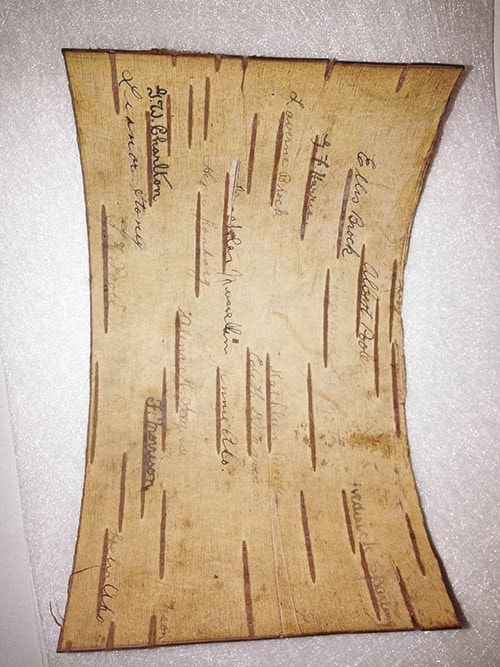By Allison White
Contributor
Most people collect and display something in their lives.
Photographs, souvenirs bought on holiday, and ticket stubs are common examples of what we showcase in our homes.
Often there is no real thought given to the overall scope of these items, just that they are to remember the event or important people in our lives. What we choose to display tells our story.
A collection is typically formed for a specific purpose.
Museums seek collections over individual objects, as a more cohesive story can be told, although it’s not always the most interesting one. There is the rare occasion that single objects cross our path, then while working backwards we find answers.
This was the case with three mysterious birch bark scrolls that where donated to the museum in 2010 from the George Sayers estate.
“George Sayers came from England with his family in 1912 and attended school in Haney before heading off to UBC. He lasted one year and could not afford to continue, but he never let that get in the way of his quest for knowledge. He became a most accomplished machinist, inventor, and botanist and was much admired by all who knew him,” said Val Patenaude, director of the Maple Ridge Museum.
After Sayers died in 1987, friends gathered some of the belongings that had been important to him, then donated that collection to the museum in 2010. The objects consisted of equipment used with Abernethy and Lougheed, the logging company with which Sayers spent most of his life working.
The tightly rolled scrolls were thought to have information or names of company employees on them. It was not until they were recently unrolled that we discovered they had nothing at all to do with the logging company.
“They were covered with signatures of very familiar names – Mussallem, Adair, Poole, Aho, Morrison, Charlton, Jackson, Leggatt, Sayers, McFarlane, and Brown. The signers were male and female, some were siblings and clearly, they were from all over the district. There was no date or any reason for their gathering,” Patenaude said.
She discovered that the group were members of the MacLean High School Literary and Athletic Club, while looking through a 1924 school annual. All the rest of the signatures belong to those in the first and second years of high school, roughly equivalent to grades 10 and 11.
MacLean was the first high school in the district, and it had opened in 1922. Its catchment was all of Maple Ridge and Pitt Meadows.
Now that we were able to put a story and faces to the signatures came the larger question: why did these scrolls survive close to 90 years inside a desk drawer?
I like to think that they were kept for a combination of historic, scientific and emotional reasons.
Historic, as MacLean was the first high school in the district.
Scientific, as they were written on birch bark. Perhaps the club was conducting an experiment.
Yet emotional is most likely the winner of the three.
Think back to when you were younger, carving your name or signing a group document was laying your claim that you were there, a part of something.
Think of our high school annuals, empty pages put in there for one thing: signatures.
Everyone wants to be remembered in some fashion, even if it is as small as on a piece of birch bark along with your classmates.
As a keeper of our community’s artifacts, it’s important to recognize that even those small pieces that might be discarded by others, if they can be linked to a larger story, they are worth saving.
Allison White is the curator of the Maple Ridge Museum.
